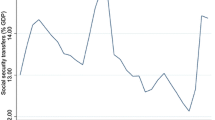Abstract
This article aims at assessing the role of the United States in the global economy and its evolution over time. Based on a Global VAR modeling approach, this article shows first that countries with a large trade exposure with the U.S. economy have a relatively larger sensitivity to U.S. developments. However, even for countries that do not trade so much with the U.S., they are largely influenced by its dominance through other partners’ trade. Moreover, while no clear trend seems to emerge, it seems that the role of the U.S. in the global economy has changed over time. Overall, for most countries—the latest recession excluded—a change in U.S. GDP had weaker impacts—though more persistent—for most recent periods. The latest recession, however, led to some renewed increase in the sensitivity of the economies to U.S. developments.
Similar content being viewed by others
References
Bayoumi T, Swiston A (2009) Foreign entanglements: estimating the source and size of spillovers across industrial countries. IMF Staff Papers 56: 353–383
Brown RL, Durbin J, Evans JM (1975) Techniques for testing the constancy of regression relationships over time. J R Stat Soc Ser B 149(162): 149–162
Canova F, Marriman J (1998) Sources and propagation of international output cycles: common shocks or transmission?. J Int Econ 46: 133–166
Chudik A (2008) GVAR approach and the dominance of the US economy. Manuscript, Faculty of Economics, University of Cambridge
Chudik A, Pesaran MH (2007) Infinite dimension VARs and factor models. Manuscript, Faculty of Economics, University of Cambridge
Dees S, di Mauro F, Pesaran MH, Smith LV (2007) Exploring the international linkages of the euro area: a GVAR analysis. J Appl Econ 22: 1–38
Dees S, Vansteenkiste I (2007) The transmission of U.S. cyclical developments to the rest of the world. European Central Bank Working Paper No 798
Dees S, Saint-Guilhem A (2009) The role of the united states in the global economy and its evolution over time. European Central Bank Working Paper No 1034
Johansen S (1992) Cointegration in partial systems and the efficiency of single-equation analysis. J Econ 52: 231–254
Kilian L (1998) Small-sample confidence intervals for impulse response functions. Rev Econ Stat 80: 218–230
Koop G, Pesaran MH, Potter SM (1996) Impulse response analysis in nonlinear multivariate models. J Econ 74: 119–147
Kose MA, Otrok C, Whiteman CH (2003) International business cycles: world, region and country-specific factors. Am Econ Rev 93: 1216–1239
Mac Kinnon JG, Haug AA, Michaelis L (1999) Numerical distribution functions of likelihood ratio tests for cointegration. J Appl Econ 14: 563–577
Osborn D, Perez P, Sensier M (2005) Business cycle linkages for the G7 countries: does the U.S. lead the world? University of Manchester, CGBCR Discussion Paper No 50
Pesaran MH, Schuermann T, Weiner SM (2004) Modelling regional interdependencies using a global error-correcting macroeconometric model. J Bus Econ Stat 22: 129–162
Pesaran MH, Schuermann T, Smith LV (2009) Forecasting economic and financial variables with global VARs. Int J Forecast 25: 642–675
Stock JH, Watson MW (2005) Understanding changes in international business cycle dynamics. J Eur Econ Assoc 3: 968–1006
Yamagata T (1998) Analogous cycles with lagged co-movement: U.S. and East Asian business cycles. Dev Econ 36: 407–439
Author information
Authors and Affiliations
Corresponding author
Additional information
Any views expressed represent those of the authors and not necessarily those of the European Central Bank or the Eurosystem.
Rights and permissions
About this article
Cite this article
Dees, S., Saint-Guilhem, A. The role of the United States in the global economy and its evolution over time. Empir Econ 41, 573–591 (2011). https://doi.org/10.1007/s00181-010-0407-2
Received:
Accepted:
Published:
Issue Date:
DOI: https://doi.org/10.1007/s00181-010-0407-2




